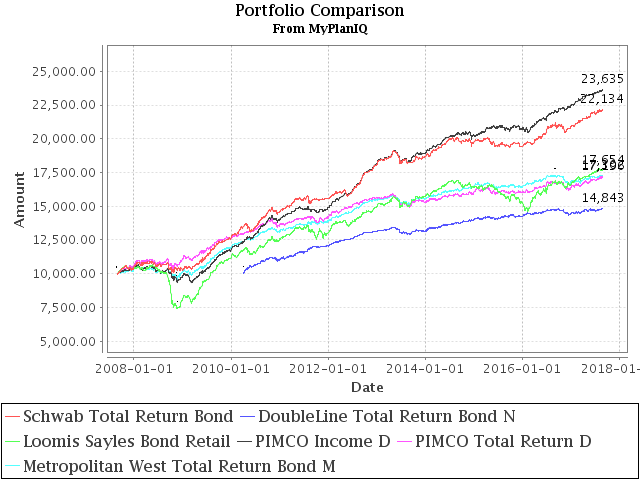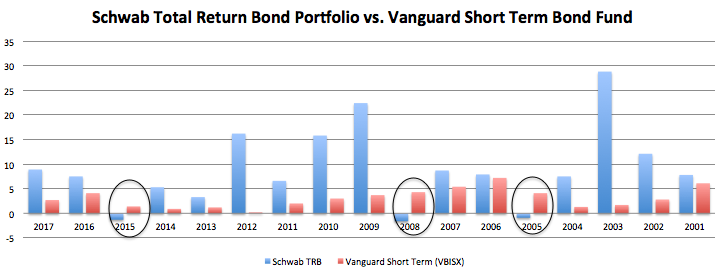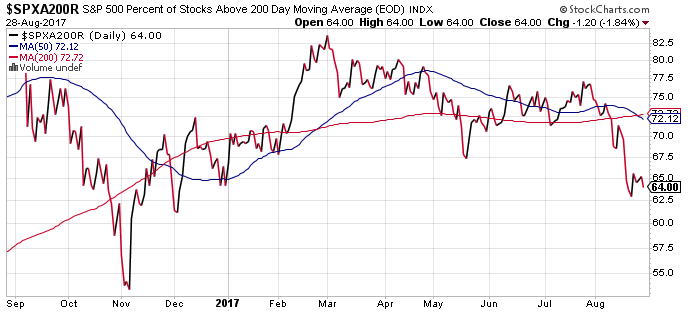Total Return Bond Fund Portfolios: Where Do They Fit?
We often received questions regarding our total return bond fund portfolios (see those listed on What We Do -> Brokerage Investors page). Users are especially interested in where these portfolios fit in, compared with various types of bond funds. In this newsletter, we will compare them with representative funds in popular categories.
First, let’s look at their recent performance, compared with the popular total return bond funds:
Recent performance
| Ticker/Portfolio Name | YTD Return** |
1Yr AR | 3Yr AR | 5Yr AR | 10Yr AR | 10Yr Sharpe |
|---|---|---|---|---|---|---|
| Schwab Total Return Bond | 5.9% | 5.6% | 3.3% | 5.8% | 8.3% | 1.81 |
| DLTNX (DoubleLine Total Return Bond N) | 2.5% | 0.7% | 2.5% | 2.9% | ||
| LSBRX (Loomis Sayles Bond Retail) | 6.7% | 5.5% | 1.7% | 4.5% | 5.9% | 1.02 |
| PONDX (PIMCO Income D) | 5.2% | 7.9% | 5.2% | 7.2% | 9.0% | 2.14 |
| PTTDX (PIMCO Total Return D) | 4.9% | 2.7% | 2.7% | 2.5% | 5.6% | 1.28 |
| MWTRX (Metropolitan West Total Return Bond M) | 2.9% | 0.3% | 2.2% | 3.0% | 5.7% | 1.38 |
So far this year, the portfolio has done well enough, only behind LSBRX (Loomis Sayles Bond Retail), which overweights in low quality junk bonds.
We note that PONDX (PIMCO Income D) is the only one that outperformed the portfolio in the past 10 years. This fund has been remarkable since its inception in 2007. However, as we have emphasized many times, our portfolios are designed to perform competitively while in the meantime to have downside protection in case one of the star candidate funds falters. We have seen this before: for example, from 12/31/2000 to 12/31/2007, LSBRX was practically ahead of the portfolio almost every year. However, it incurred a big loss in 2008 that has severely affected its returns.
How are the total return bond fund portfolio compared with intermediate bond funds
It’s an easier comparison with representative intermediate bond funds:
| Ticker/Portfolio Name | YTD Return** |
1Yr AR | 3Yr AR | 5Yr AR | 10Yr AR | 10Yr Sharpe |
|---|---|---|---|---|---|---|
| Schwab Total Return Bond | 5.9% | 5.6% | 3.3% | 5.8% | 8.3% | 1.81 |
| VFICX (Vanguard Interm-Term Invmt-Grade Inv) | 4.1% | 1.2% | 3.4% | 3.3% | 5.5% | 1.06 |
| VFITX (Vanguard Interm-Term Treasury Inv) | 2.6% | -0.6% | 2.2% | 1.4% | 4.3% | 0.82 |
| VBIIX (Vanguard Interm-Term Bond Index Inv) | 4.2% | 0.1% | 3.0% | 2.6% | 5.4% | 0.9 |
| VBMFX (Vanguard Total Bond Market Index Inv) | 3.2% | 0.0% | 2.5% | 2.1% | 4.3% | 0.99 |
The portfolio did better than virtually every of these funds in last 3, 5, and 10 year periods (except that it was a bit lower 3.3% vs. 3.4% than VFICX in the last 3 years). This should be expected as that is the purpose of these portfolios.
But how about risky bond funds such as high yield bond funds and global (international) bond funds?
| Ticker/Portfolio Name | YTD Return** |
1Yr AR | 3Yr AR | 5Yr AR | 10Yr AR | 10Yr Sharpe |
|---|---|---|---|---|---|---|
| Schwab Total Return Bond | 5.9% | 5.6% | 3.3% | 5.8% | 8.3% | 1.81 |
| VWEHX (Vanguard High-Yield Corporate Inv) | 5.3% | 7.2% | 4.8% | 5.8% | 6.9% | 1.3 |
| TGBAX (Templeton Global Bond Adv) | 2.7% | 10.5% | 0.9% | 3% | 6.6% | 0.34 |
So, even if you attempt to have exposure in highly risky junk (high yield) bonds, it looks like there is no point to have this stand alone exposure as the portfolio has done better than a high yield bond fund like VWEHX because it can tactically invest in these bonds (through funds like Loomis Sayles LSBRX, PIMCO Income PONDX, for example).
Templeton Global Bond fund TGBAX is an excellent global bond fund that can sizably invest anywhere including emerging market bonds. Again, because our total return bond funds can also dabble into foreign bonds (for example, PIMCO total return bond fund PTTDX or DoubleLine DLTNX are known to invest in foreign bonds), the portfolio outdid these global bond funds.
How about short term bond funds?
It’s tempting to treat these total return bond fund portfolios as short term investments. Let’s take a look:
We can see the portfolio lost in 3 years in the last 16+ years. As we stated in our recent newsletter July 24, 2017: Total Return Bond Fund Portfolios And Cash, the total return bond fund portfolios should be held for more than 2 years to at least smooth out their volatilities. They are not qualified to be treated as a short term bond fund replacement.
Summary
Other than short term cash, total return bond fund portfolios can replace individual holdings of various intermediate bond funds. These portfolios can be treated as the core fixed income holdings in one’s overall investments.
Market Overview
Stocks continue to defy many investors (us included) and hang in near their historical highs. International and emerging market stocks are still showing strength while US stocks are showing some weakness. High yield bonds recovered. For now, the party continues, albeit showing some fatigue. However, if one looks under the hood more closely, we find the recent markets are more concerning: based on StockCharts, the percentage of stocks in S&P 500 that are above their 200 day moving averages continues to decline:
Apparently, market health is declining, though not enough to call for adjustment yet. But as we have said all along, this is the time to be cautious and risk averse.
For more detailed asset trend scores, please refer to 360° Market Overview.
Now that the Trump administration has been in the office for more than half a year, it has stumbled and encountered many difficulties to implement its promised changes in terms of tax cuts, job stimulation and infrastructure spending. On the other hand, stocks continued to ascend, regardless of the progress. Looking ahead, however, we remain convinced that markets will experience more volatilities at some point when reality finally sets in.
In terms of investments, U.S. stock valuation is at a historically high level. It is thus not a good time to take excessive risk. However, we remain optimistic on U.S. economy in the long term and believe much better investment opportunities will arise in the future.
We again would like to stress for any new investor and new money, the best way to step into this kind of markets is through dollar cost average (DCA), i.e. invest and/or follow a model portfolio in several phases (such as 2 or 3 months) instead of the whole sum at one shot.
Latest Articles
- August 14, 2017: Fidelity Commission Free ETFs Update
- August 7, 2017: I Didn’t Learn Anything — Mistake vs. Temporary Underperformance
- July 31, 2017: Asset Classes And Fund Choices: A Primer
- July 24, 2017: Total Return Bond Fund Portfolios And Cash
- July 17, 2017: Long Term Stock Holding Periods For Retirement
- July 10, 2017: Half Year Asset Trend Review
- June 26, 2017: How To Beat The Best Balanced Allocation Fund
- June 19, 2017: Newsletter Collection Update
- June 12, 2017: A Mixed Bag Performance of Momentum Investing
- June 5, 2017: How To Start A New Portfolio
- May 29, 2017: Alternative Assets And Their Role In Portfolios
- May 22, 2017: Summer Seasonality And Portfolio Management
- May 15, 2017: Cash: Banking Or Investing?
- May 8, 2017: Holding Period of Long Term Timing Portfolios
- May 1, 2017: Debate on Risk vs. Volatility
- April 24, 2017: The Long Term Stock Market Timing Return Since 1871
- April 17, 2017: Risk vs. Volatility: Long Term Stock Market Returns
- April 10, 2017: Total Return Bond ETFs And Portfolios
- April 3, 2017: Quarter End Asset Trend Review
- March 27, 2017: Practical Consideration For IRAs And 401k Accounts
- March 20, 2017: Fund Fees: That’s (Still) Outrageous
- March 13, 2017: Long Term Stock Valuation Review
- March 6, 2017: Asset Classes for Retirement Investments
- February 27, 2017: Fidelity Total Bond Fund Review
- February 20, 2017: Long Term Stock Timing Based Portfolios And Their Roles
- February 13, 2017: Alternative Investment Portfolios Review
- February 6, 2017: Tax Free Municipal Bond Investments Review
- January 30, 2017: Brokerage Specific Conservative Portfolios
- January 23, 2017: Fixed Income Portfolio Review
- January 16, 2017: Long Term Trend Following Portfolio Review
- January 9, 2017: Tactical Asset Allocation Review
- January 3, 2017: Strategic Asset Allocation Review
- December 12, 2016: Enhanced Index Funds
- December 5, 2016: Review Of Broad Base Core Mutual Funds For Brokerages
- November 28, 2016: Core Index ETFs Review
- November 21, 2016: International Exposure Of U.S. Large Companies
- November 14, 2016: Asset Trends After The Election
- November 7, 2016: Rising Rate And Current Bond Trend
- October 31, 2016: Economy Power And Long Term Stock Returns
- October 24, 2016: Current Commodity Trend And Managed Futures
- October 17, 2016: Investment Mistakes And Good Or Bad Investment Strategies
- October 10, 2016: Momentum Investing Review
- October 3, 2016: Survey & Feedback
- September 26, 2016: Fixed Income Investing: Actively Managed Funds vs. Index Funds
- September 19, 2016: Stock Investing: Actively Managed Funds vs. Index Funds
- September 12, 2016: Newsletter Update
- September 5, 2016: Overvalued Markets And Long Term Timing Strategies
- August 29, 2016: Your 401K Finally Draws Attention
- August 22, 2016: Inflation Protected Securities TIPS For Current Overvalued Markets
- August 15, 2016: Risk On: Emerging Market Stocks And Small Cap Stocks
- August 8, 2016: Portfolio Construction Using Stock ETFs And Bond Mutual Funds
- August 1, 2016: Adding Value To Your Own Investments
- July 25, 2016: Tactical Asset Allocation Funds Review
- July 18, 2016: Strategic Asset Allocation & Lazy Portfolio Review
- July 11, 2016: Asset Trend Review
- June 27, 2016: Secular Cycles For Tactical And Strategic Investment Strategies
- June 20, 2016: A World of Debt
- June 13, 2016: Managed Futures For Portfolio Building
- June 6, 2016: Newsletter Summary
- May 30, 2016: Swensen Portfolio And Permanent Portfolios
- May 23, 2016: AAII Article And Some Web Changes
- May 16, 2016: The PIMCO (Dis)Advantages
- May 9, 2016: Boost Your Dull Summer Investments
- May 2, 2016: Low Cost Index Fund Investing
- April 25, 2016: Tax Free Municipal Bond Funds & Portfolios
- April 18, 2016: Asset Class Trend Review
- April 11, 2016: Construction of Sound And Conservative Portfolios
- March 28, 2016: Total Return Bond ETFs Review
- March 21, 2016: Small And Large Company Stock Performance In Different Economic Expansion Cycles
- March 14, 2016: Are Tactical And Timing Strategies Losing Steam?
- March 7, 2016: Defined Maturity Bond Fund Analysis
- February 29, 2016: Smart Strategic Asset Allocation Rebalance When Market Trend Changes
- February 22, 2016: Be Cash Smart
- February 15, 2016: Bond ETF Portfolios
- February 8, 2016: Newsletter Collection Update
- February 1, 2016: Total Return Bond Fund Portfolios In A Volatile Period
- January 25, 2016: Alternative Portfolios Review
- January 18, 2016: Strategic Asset Allocation: A Cautious Outlook
- January 11, 2016: Review Of Trend Following Tactical Asset Allocation
- January 4, 2016: What Worked And Didn’t In 2015
- December 21, 2015: Distressed Assets
- December 14, 2015: High Yield Bonds And Their Correlation With Stocks
- December 7, 2015: Diversification And Global Allocation
- November 30, 2015: Investors and Speculators Combined
- November 23, 2015: Active Stock Fund Performance Consistency
- November 16, 2015: Permanent, Risk Parity And Alternative Portfolios Review
- November 9, 2015: Broad Base Core Mutual Fund Review
- November 2, 2015: Broad Base Index Core ETFs Review
- October 26, 2015: Total Return Bond Fund Review
- October 19, 2015: Advanced Portfolio Review
- October 12, 2015: What About Commodities?
- October 5, 2015: Core Satellite Portfolios In A 401k Account
- September 28, 2015: Risk Managed Strategic Asset Allocation Portfolios Revisited
- September 21, 2015: Quest For The Best Investment Strategy
- September 14, 2015: Core Satellite Portfolios In Market Turmoil
- September 7, 2015: Market Rout Creates An Opportunity to Reposition Your Portfolios
- August 31, 2015: Review of Asset Allocation Funds and Portfolios
- August 24, 2015: Market Rout And Your Portfolios
- August 17, 2015: ETF or Mutual Fund Based Portfolios
- August 10, 2015: Updated Newsletter Collection
- August 3, 2015: Slippery Asset Trends
- July 27, 2015: Performance Dispersion Among Momentum Based Portfolios
- July 20, 2015: Global Balanced Portfolio Benchmarks
- July 13, 2015: Pain in Tactical Portfolios
- July 6, 2015: Fixed Income Total Return Bond Funds In Strategic Asset Allocation Portfolios
- June 29, 2015: Core ETF Commission Free Portfolios
- June 22, 2015: Secular Asset Trends
- June 15, 2015: Giving Up Bonds?
- June 1, 2015: Summer Blues?
- May 26, 2015: Cash, Bonds and Stocks In A Rising Rate Environment
- May 18, 2015: Portfolio Update
- May 11, 2015: Pain in Fixed Income?
- May 4, 2015: The Balanced Stock and Long Term Treasury Bond Portfolios
- April 27, 2015: Long Term Treasury Bond Behavior
- April 20, 2015: 529 College Savings Plan Rebalance Policy Change
- April 13, 2015: Total Return Bond Funds As Smart Cash
- April 6, 2015: The Low Return Environment
- March 30, 2015: Brokerage Specific Core Mutual Fund Portfolios 2
- March 23, 2015: Investment Arithmetic for Long Term Investments
- March 16, 2015: Brokerage Specific Core Mutual Fund Portfolios
- March 9, 2015: Newsletter Collection Update
- March 2, 2015: Total Return Bond ETFs
- February 23, 2015: Why Is Global Tactical Asset Allocation Not Popular?
- February 16, 2015: Where Are Permanent Portfolios Going?
- February 9, 2015: How Have Asset Allocation Funds Done?
- February 2, 2015: Risk Management Everywhere
- January 26, 2015: Composite Portfolios Review
- January 19, 2015: Fixed Income Investing Review
- January 12, 2015: How Does Trend Following Tactical Asset Allocation Strategy Deliver Returns
- January 5, 2015: When Forecast Fails
- December 22, 2014: Long Term Asset Returns: How Long Is Long?
- December 15, 2014: Beaten Down Assets
- December 8, 2014: Implementing Core Asset Portfolios In a Brokerage
- December 1, 2014: Two Key Issues of Investment Strategies
- November 24, 2014: Holiday Readings
- November 17, 2014: Retirement Spending Portfolios Update
- November 10, 2014: Fixed Income Or Cash
- November 3, 2014: Asset Trend Review
- October 27, 2014: Investment Loss, Mistakes And Market Cycles
- October 20, 2014: Strategic Portfolios With Managed Volatility
- October 13, 2014: Embrace Volatility
- October 6, 2014: Tips For 401k Open Enrollment
- September 29, 2014: What Can We Learn From Bill Gross’ Departure From PIMCO?
- September 22, 2014: Why Total Return Bond Funds?
- September 15, 2014: Equity And Total Return Bond Fund Composite Portfolios
- September 8, 2014: Momentum Based Portfolios Review
- September 1, 2014: Risk & Diversification: Mint.com Interview
- August 25, 2014: Remember Risk
- August 18, 2014: Consistency, The Most Important Edge In Investing: Tactical Case
- August 11, 2014: What To Do In Overvalued Stock Markets
- August 4, 2014: Is This The Peak Or Correction?
- July 28, 2014: Stock Musings
- July 21, 2014: Permanent Portfolios & Four Pillar Foundation Based Framework
- July 14, 2014: Composite Portfolios Review
- July 7, 2014: Portfolio Behavior During Market Corrections
- June 30, 2014: Half Year Brokerage ETF and Mutual Fund Portfolios Review
- June 23, 2014: Newsletter Collection Update
- June 16, 2014: There Are Always Lottery Winners
- June 9, 2014: The Arithmetic of Investment Mistakes
- June 2, 2014: Tips On Portfolio Rebalance
- May 26, 2014: In Praise Of Low Cost Core Asset Class Based Portfolios
- May 19, 2014: Consistency, The Most Important Edge In Investing: Strategic Case
- May 12, 2014: How To Handle An Elevated Overvalued Market
- May 5, 2014: Asset Allocation Funds Review
- April 28, 2014: Now The Economy Backs To The ‘Old Normal’, Should Our Investments Too?
- April 21, 2014: Total Return Bond Investing In The Current Market Environment
Enjoy Newsletter
How can we improve this newsletter? Please take our survey
–Thanks to those who have already contributed — we appreciate it.




